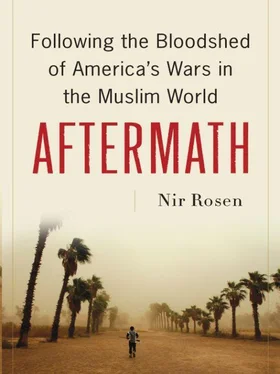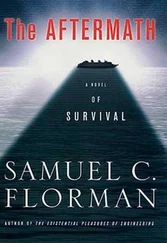Nothing was unique about Hizballah possessing an armed wing. “All the sectarian militias have weapons,” he said. “The only thing we have that they don’t have is missiles, and these cannot be used in a civil war.” But Musawi conceded that Hizballah might not have succeeded in explaining its position on Syria to the people of the north, who had suffered under the Syrian occupation, but he reminded me that until the mid-1990s the Syrians had supported Hizballah’s rivals. “I won’t defend the military, political, or security performance of the Syrians. We were the first victims of the Syrians.” He also reminded me that most of the so-called anti-Syrian politicians had collaborated closely with the Syrians politically and financially until the Hariri assassination. They had thanked Syria in 2005 for one reason, he said: their support for the resistance. “We are friends or enemies based on the position on Israel, not a struggle for power or sectarian differences.”
Superglue and Sectarianism
As the Americans tried to galvanize Sunnis in the region to view Iran and its allies as a threat, they showed more signs of succeeding in Lebanon than anywhere outside Iraq. Events in Beirut in early 2008 reminded me of Baghdad in 2004, when the civil war was just beginning and every morning we would hear of small sectarian incidents. New militias were being formed, such as the all-Sunni Tripoli Brigades in the north. In Beirut, street fights regularly occurred between members of the Future Movement and the Shiite Amal Movement. Amal’s young men were more thuggish, and the movement was less ideological and disciplined than Hizballah, which normally avoided being drawn into internal conflict.
In December 2007 Brig. Gen. Francois al-Hajj was killed by a car bomb. It was the twelfth political assassination in the past three years but the first targeting an army officer. Hajj was expected to be the next commander of Lebanon’s army, but he had also been in charge of the army’s operations in Nahr al-Barid. He had been the army’s liaison with Hizballah and was not at all close to the March 14 camp, so it seemed unlikely that opposition forces were behind it. On the other hand, it may have been the hand of Fatah al-Islam reaching out for revenge. At an opposition demonstration, the army shot and killed seven Shiites who were protesting extended power cuts, complaining that the pro-opposition area of Dahiyeh had more cuts than progovernment Christian and Sunni areas. Neglect of Shiites was the whole reason Hizballah had created its so-called “state within a state.”
In the first few months of 2008 small clashes between Sunni and Shiite militias occurred regularly. A January roadside bomb targeted an American diplomatic convoy, but it was less newsworthy than the increasing sectarian polarization—which grew worse following the assassination that month of the Sunni Internal Security Forces official who was himself investigating Lebanon’s numerous political assassinations. At his funeral crowds chanted, “The blood of Sunnis is boiling!” The next month Saad al-Hariri seemed to move the country closer to a civil war. “If they are after a confrontation, we are up for the job,” the Future Movement leader announced. Sunni thugs then took to the streets and shot into the air in celebration. One Friday the sheikh of the Dhunurein Mosque, in Beirut’s Ras al-Nabaa neighborhood (formerly a front line between Christians and Muslims, now a front line between Sunnis and Shiites), declared that Beirut was occupied and Sunnis had to defend it. The implication was that Shiites were occupying Beirut and that they were the threat. The following day young men from the Shiite Amal militia vandalized the mosque. Graffiti warned Shiites to beware of Sunni rage and invoked the names of early Islamic leaders whom Shiites revile, such as Omar and Muawiya.
In Tariq al-Jadida’s main shopping street, Afif al-Tibi, there was a huge commotion one Monday morning following weekend clashes. The streets were lined with about two dozen retail and wholesale clothing stores owned by Shiites, who are a minority in this largely Sunni enclave just north of Shiite southern Beirut. At least five of these shops had their locks clogged with superglue by Future members. Earlier anti-Shiite slogans had been spray-painted on the Shiite-owned shops. After the superglue incident some Shiite shop owners felt threatened and left their shops closed, choosing to stay home. That weekend there had been intense clashes in the Ras al-Nabaa district. Members of the Future Movement had attacked an Amal Movement office. Following the fighting Future supporters stood guard at every street corner in the surrounding area. Many carried chains, metal clubs, or M-16 automatic rifles. They included Lebanese Kurds. After one young man concealed his M-16 from a passerby, another shouted at him, “Why are you hiding it? Show it, we don’t care! Let them know that we have guns too!” Shooting could be heard all night, and in Tariq al-Jadida supporters of the Future Movement destroyed the locally famous Ramadan Juice shop, which was owned by a Shiite man from Dahiyeh and had been open in the neighborhood for twenty years. Future members claimed he was a spy for Hizballah. One Future member explained why they were harassing local Shiites. “We don’t want them in Beirut,” he said. “Beirut is only for Sunnis.”
At the time of the superglue incident, the head of the local Future militia on Afif al-Tibi Street was Abu Ahmad. He had prevented hotheaded militiamen from burning down the Shiite-owned shops. He had also previously refused to arm his men or allow them to maintain a weapons depot because he sought to avoid problems with Shiites. He explained that Sunnis had been living side by side with their Shiite neighbors for many years and that they should solve their problems peacefully. He was replaced, however, by a more aggressive man, said to hate Shiites and love weapons, who armed the young men.
Although the Shiites of Tariq al-Jadida were not overtly political, it was becoming clear that they were not trusted or wanted. Militiamen assigned to intelligence duties stood watch on street corners all day long. Young men worked on various shifts, usually at night, getting paid a few hundred dollars a month, with the promise of a bonus if they took part in fighting. Some were posted in other areas, where more bodies were needed to confront the Shiite Amal movement, a less ideological and more sectarian group than Hizballah. Sunni militiamen coordinated with members of the security forces and army. The Future Movement also mobilized Sunnis from Akkar, who were considered more aggressive than Beiruti Sunnis. Other “real Sunnis” were imported from Dinniyeh and the town of Arsal in the Bekaa Valley to defend the Sunnis of Beirut. Numerous apartment and hotel rooms around the city were rented for them. The Future militias were also recruiting retired army and intelligence operatives. There was even a Future security company in Tariq al-Jadida, its office festooned with posters of Rafiq and Saad al-Hariri. Senior March 14 leader Walid Jumblatt confided to me that Sunnis were joining militias and training in Jordan. He disapproved of this and said they should join the security forces.
Shaqer al-Berjawi was one of the new militia leaders in Tariq al-Jadida. His movement was called the Arab Current. Berjawi had once belonged to the Murabitun militia and fought in west Beirut during the civil war. After Hariri was assassinated, he began forming his new movement (with support from the Future Movement) because Sunnis felt leaderless and weak. He recruited Fatah supporters from the Palestinian camps to fight alongside Sunnis, a growing phenomenon. Hamas members in Beirut blame his people for clashes that occurred between rival Palestinian factions. Berjawi participated in the January 2007 clashes and is rumored to be among the Sunni snipers who were targeting Shiites. He was arrested afterward and accused of weapons smuggling but soon was released.
Читать дальше











